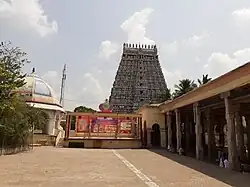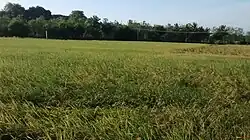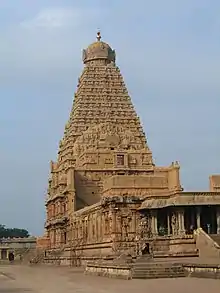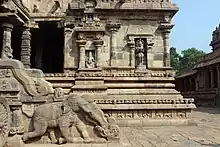Thanjavur district
Thanjavur district is one of the 38 districts of the state of Tamil Nadu, in southeastern India. Its headquarters is Thanjavur. The district is located in the delta of the Cauvery River and is mostly agrarian.
Thanjavur district | |
|---|---|
 _(37498380391).jpg.webp)   | |
| Nickname: Rice Bowl of Tamil Nadu | |
.svg.png.webp) Location in Tamil Nadu | |
| Coordinates: 10°47′8.16″N 79°8′24.36″E | |
| Country | |
| State | |
| Municipal Corporations | Thanjavur, Kumbakonam |
| Municipalities | Pattukkottai, Adirampattinam |
| Largest city | Thanjavur |
| Headquarters | Thanjavur |
| Talukas | Budalur, Kumbakonam, Orathanadu, Papanasam, Pattukkottai, Peravurani, Thanjavur, Thiruvaiyaru, Thiruvidaimarudur, Thiruvonam |
| Government | |
| • District Collector | Deepak jackob, IAS[1] |
| • Superintendent of Police | Aashish Rawath, IPS[2] |
| Population (2011) | |
| • Total | 2,405,890 |
| Languages | |
| • Official | Tamil |
| Time zone | UTC+5:30 (IST) |
| PIN | 613xxx |
| Telephone code | 0436,0435 |
| ISO 3166 code | ISO 3166-2:IN |
| Vehicle registration | TN-49, TN-68[3] |
| Website | thanjavur |
Geography


The district is located at 10.08°N 79.16°E in Central Tamil Nadu bounded on the northeast by Mayiladuthurai district, on the east by Tiruvarur District, on the south by the Palk Strait of Bay of Bengal on the west by Pudukkottai District and Tiruchirappalli, small border with Cuddalore on the northeast and on the north by the river Kollidam, across which lie part of Tiruchirappalli, and Ariyalur districts.
Demographics
| Year | Pop. | ±% p.a. |
|---|---|---|
| 1901 | 928,222 | — |
| 1911 | 978,651 | +0.53% |
| 1921 | 958,929 | −0.20% |
| 1931 | 986,308 | +0.28% |
| 1941 | 1,059,583 | +0.72% |
| 1951 | 1,228,360 | +1.49% |
| 1961 | 1,317,920 | +0.71% |
| 1971 | 1,592,998 | +1.91% |
| 1981 | 1,848,132 | +1.50% |
| 1991 | 2,053,760 | +1.06% |
| 2001 | 2,216,138 | +0.76% |
| 2011 | 2,405,890 | +0.82% |
| source:[4] | ||
According to the 2011 census, Thanjavur district had a population of 2,405,890 with a sex-ratio of 1,035 females for every 1,000 males, much above the national average of 929. 35.39% of the population lived in urban areas.[6] A total of 238,598 were under the age of six, constituting 121,949 males and 116,649 females. Scheduled Castes and Scheduled Tribes accounted for 18.91% and 0.15% of the population, respectively. The average literacy of the district was 74.44%, compared to the national average of 72.99%.[6] The district had a total of 605,363 households. There were a total of 974,079 workers, comprising 117,321 cultivators, 327,673 main agricultural labourers, 26,430 in house hold industries, 363,060 other workers, 139,595 marginal workers, 12,592 marginal cultivators, 87,688 marginal agricultural labourers, 4,770 marginal workers in household industries and 34,545 other marginal workers.[7]
At the time of the 2011 census, 97.42% of the population spoke Tamil and 1.07% Saurashtra as their first language.[8]
Politics
| District | No. | Constituency | Name | Party | Alliance | Remarks | ||
|---|---|---|---|---|---|---|---|---|
| Thanjavur | 170 | Thiruvidaimarudur (SC) | Go. Vi. Chezhiyan | Dravida Munnetra Kazhagam | INDIA | Chief Whip of the Government | ||
| 171 | Kumbakonam | G. Anbazhagan | Dravida Munnetra Kazhagam | INDIA | ||||
| 172 | Papanasam | Dr. M. H. Jawahirullah | Dravida Munnetra Kazhagam (MMK) | INDIA | ||||
| 173 | Thiruvaiyaru | Durai Chandrasekaran | Dravida Munnetra Kazhagam | INDIA | ||||
| 174 | Thanjavur | T. K. G. Neelamegam | Dravida Munnetra Kazhagam | INDIA | ||||
| 175 | Orathanadu | R. Vaithilingam | Independent | Independent | ||||
| 176 | Pattukkottai | K. Annadurai | Dravida Munnetra Kazhagam | INDIA | ||||
| 177 | Peravurani | N. Ashok Kumar | Dravida Munnetra Kazhagam | INDIA | ||||
Economy
Agriculture
Thanjavur district lies in the Kaveri delta, the most fertile region in the state.[9] The district is the main rice producing region in the state and hence known as the Rice Bowl of Tamil Nadu.[10] The Kaveri River and its tributaries irrigate the district. Apart from paddy, farmers here grow coconut and sugarcane and it is the largest producer of coconut in Tamil Nadu. Being an agrarian economy, industrial growth in the district is mainly confined to agro-based industries. Many rice mills and oil mills are spread over the district.
Tourism
Great Living Chola Temples of Thanjavur

Thanjavur's Brihadisvara Temple (known also as Rajarajesvaram or Peruvudaiyār Kōvil), built by the Cholas and now a UNESCO World Heritage Site, is one of the largest of its kind and also one of the finest examples of classical Dravidian architecture in the world. Airavateswara Temple, in Darasuram, near Kumbakonam, has also been designated part of the same UNESCO World Heritage site and forms another major tourist attraction of the district. The green paddy fields of the Kaveri river valley provide a picturesque setting for these and other important ancient monuments of the district.
Manora Fort
The Manora Fort is situated 20 km (12 mi) away from Pattukkottai and 60 km (37 mi) from Thanjavur in the village of Mallipattinam. The fort was built by Maratha ruler Serfoji II in 1814–1815 to commemorate the successful advance of the British over Napoléon Bonaparte. Overlooking the Bay of Bengal, the fort is hexagonal structure and has eight storeys, raising to a height of 75 ft (23 m), tapering to its top. The tower is surrounded by a wall and a moat, resembling a fort. The monument looks like a pagoda, with arched windows, circular staircase and eaves separating one storey from the other.
Flora
The flora of Thanjavur was studied and documented in some detail by S. A. Ganapathy for a doctoral thesis in 1992.[11]
Cultural significance
Thanjavur is famous for the Saraswati veena (the national instrument), Thanjavur art plates, Thanjavur oil paintings and Thalaiyatti Bommai.
Notable people
- Rao Bahadur Sir A. T. Pannirselvam Udaiyar, Leader of justice party
- V. S. Srinivasa Sastri
- Srinivasa Ramanujan
- Sivaji Ganesan, actor and former Rajya Sabha Member
- K. Thulasiah Vandayar, former MP
- G K Moopanar TMC- Congress
- G. K. Vasan Rajya Sabha Member
- S. S. Palanimanickam, former Central Minister
- S.D Somasundaram EX Minister and MP
- Parasuram EX MP – Loksabha
- L. Ganesan – EX MLA, MP, MLC
- R. VaithiyaLingam – Ex Minister and Rajya Sabha Member
- M Ramachandran MLA – DMk
- Durai Govindarajan EX MLA
- Durai Chandrasekaran MLA
- R. Doraikkannu Ex. Minister for Agricultural, Tamil Nadu
See also
- Achanoor
- Adirampattinam
- Ayyampettai
- Chola Nadu
- Kangeyampatti
- Karaimeendarkottai
- Keelakorukkai
- Keeranur
- Kelavannipet
- Kodiyalam
- Kollangarai Vallundanpattu
- Kondavattanthidal
- Kothangudithattimal
- Kotrapatti
- Kovanoor
- Kullangarai
- Kumbakonam
- Kurungulam Melpathi
- List of districts of Tamil Nadu
- Madukkur
- Orathanadu Taluk
- Ottankadu
- Palaiyanallur
- Palayee Agraharam
- Pallathur
- Palliodiaivayal
- Pandipalamavikadu
- Pangal
- Pannikondaviduthy
- Paravathur
- Pattukkottai
- Perappadi
- Peravurani
- Perumbur IInd Sethi
- Pillaiyarmatham
- Pinnai Nallur
- Ponkundu
- Temples of Kumbakonam
Notes and references
- district Collector
- City Superintendent of Police
- www.tn.gov.in
- Decadal Variation In Population Since 1901
- "Table C-01 Population by Religion: Tamil Nadu". censusindia.gov.in. Registrar General and Census Commissioner of India. 2011.
- "Census Info 2011 Final population totals". Office of The Registrar General and Census Commissioner, Ministry of Home Affairs, Government of India. 2013. Retrieved 26 January 2014.
- "Census Info 2011 Final population totals – Thanjavur district". Office of The Registrar General and Census Commissioner, Ministry of Home Affairs, Government of India. 2013. Retrieved 26 January 2014.
- "Table C-16 Population by Mother Tongue: Tamil Nadu". Census of India. Registrar General and Census Commissioner of India.
- Nathan, K. K. (October 1995). "Assessment of Recent Droughts in Tamil Nadu" (PDF). Drought Network News. Archived from the original (PDF) on 17 March 2003.
- "Welcome to Thanjavur (District Official Website)". District Administration of Thanjavur. Archived from the original on 3 February 2006. Retrieved 22 January 2012.
- Ragupathy, Subramanyam (1992). Flora of Thanjavur District. Doctoral dissertation, PhD thesis. Madras, India: Centre for Advanced Study in Botany, University of Madras.
External links
| Rank | Taluk | Pop. | |||||||
|---|---|---|---|---|---|---|---|---|---|
.jpg.webp) Thanjavur  Kumbakonam |
1 | Thanjavur | Thanjavur taluk | 290,724 | |||||
| 2 | Kumbakonam | Kumbakonam taluk | 140,156 | ||||||
| 3 | Pattukkottai | Pattukkottai taluk | 73,135 | ||||||
| 4 | Adiramapattinam | Pattukkottai taluk | 31,066 | ||||||
| 5 | Peravurani | Peravurani taluk | 21,035 | ||||||
| 6 | Papanasam | Papanasam taluk | 16,397 | ||||||
| 7 | Madukkur | Pattukkottai taluk | 15,436 | ||||||
| 8 | Thiruvaiyaru | Thiruvaiyaru taluk | 14,535 | ||||||
| 9 | Vallam | Thanjavur taluk | 14,495 | ||||||
| 10 | Ayyampettai (Thanjavur district) | Papanasam taluk | 14,202 | ||||||

